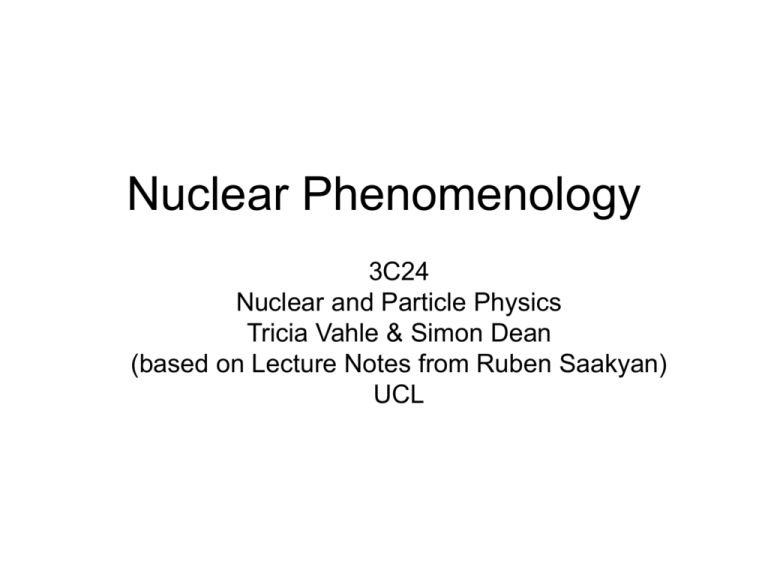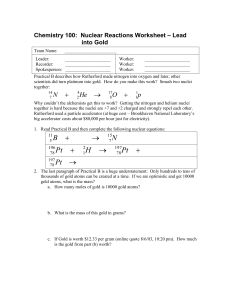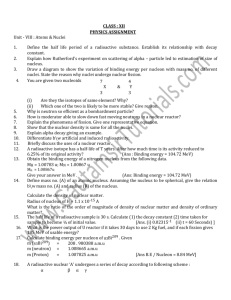Nuclear Phenomenology
advertisement

Nuclear Phenomenology 3C24 Nuclear and Particle Physics Tricia Vahle & Simon Dean (based on Lecture Notes from Ruben Saakyan) UCL Nuclear Notation • Z – atomic number = number of protons N – neutron number = number of neutrons A – mass number = number of nucleons (Z+N) • Nuclides AX (16O, 40Ca, 55Fe etc…) – Nuclides with the same A – isobars – Nuclides with the same Z – isotopes – Nuclides with the same N – isotones Masses and binding energies • Something we know very well: – Mp = 938.272 MeV/c2, Mn = 939.566 MeV/c2 • One might think that – M(Z,A) = Z Mp + N Mn - not the case !!! • In real life – M(Z,A) < Z Mp + N Mn • The mass deficit DM(Z,A) = M(Z,A) - Z Mp - N Mn – –DMc2 – the binding energy B. – B/A – the binding energy per nucleon, the minimum energy required to remove a nucleon from the nucleus Binding energy Binding energy per nucleon as function of A for stable nuclei Nuclear Forces • Existence of stable nuclei suggests attractive force between nucleons • But they do not collapse there must be a repulsive core at very short ranges • From pp-scattering, the range of nucleonnucleon force is short which does not correspond to the exchange of gluons Nuclear Forces d +V0 V(r) r=R d<<R Range~R B/A ~ V0 0 r • Charge symmetric pp=nn • Almost charge –independent pp=nn=pn – mirror nuclei, e.g. 11B 11C • Strongly spin-dependent – Deutron exists: pn with spin-1 – pn with spin-0 does not • Nuclear forces saturate (B/A is not proportional to A) -V0 Approximate description of nuclear potential Nuclei. Shapes and sizes. • Scattering experiments to find out shapes and sizes • Rutherford cross-section: Z 2 2 ( c) 2 d 2 4 d 4 E sin ( / 2) Rutherford • Taking into account spin: Mott cross-section d d 2 2 1 sin ( / 2) , d Mott d Rutherford v c Nuclei. Shapes and Sizes. • Nucleus is not an elementary particle • Spatial extension must be taken into account • If f ( x ) – spatial charge distribution, then we define form factor F (q 2 ) as the Fourier transform of f ( x ) 1 iq x / 3 F (q ) e f ( x ) d x, Ze 2 Ze f ( x )d 3 x d d 2 2 F (q ) d exp t d Mott F (q 2 ) can be extracted experimentally, then f ( x ) found from inverse Fourier transform Ze 2 iq x / 3 f (x) F ( q )e d q 3 (2 ) In practice d/d falls very rapidly with angle Shapes and sizes • Parameterised form is chosen for charge distribution, form-factor is calculated from Fourier transform • A fit made to the data • Resulting charge distributions can be fitted by ch (r ) 1 e 0 ch ( r c ) / a c = 1.07A1/3 fm a = 0.54 fm • Charge density approximately constant in the nuclear interior and falls rapidly to zero at the nuclear surface Radial charge distribution of various nuclei Shapes and sizes • Mean square radius r 2 1/ 2 ~ 2 1/ 3 r ( r ) dr 0.94 A fm for medium and heavy nuclei ch • Homogeneous charged sphere is a good approximation Rcharge = 1.21 A1/3 fm • If instead of electrons we will use hadrons to bombard nuclei, we can probe the nuclear density of nuclei nucl ≈ 0.17 nucleons/fm3 Rnuclear ≈ 1.2 A1/3 fm Liquid drop model: semi-empirical mass formula • Semi-empirical formula: theoretical basis combined with fits to experimental data • Assumptions – The interior mass densities are approximately equal – Total binding energies approximately proportional their masses 5 M ( Z , A) f i ( Z , A) i 0 Semi-empirical mass formula • “0th“term f 0 ( Z , A) ZM p ( A Z ) M n • 1st correction, volume term f1 ( Z , A) a1 A • 2d correction, surface term f 2 ( Z , A) a2 A2 / 3 • 3d correction, Coulomb term Z2 f3 ( Z , A) a3 1/ 3 A Semi-empirical mass formula • 4th correction, asymmetry term ( Z A / 2)2 f 4 ( Z , A) a4 A • Taking into account spins and Pauli principle gives 5th correction, pairing term f5 ( Z , A) f ( A), if Z even, A - Z N even f5 ( Z , A) 0, if Z even, A - Z N odd; or Z odd, A - Z N even f5 ( Z , A) f ( A), if Z odd, A - Z N odd f ( A) a5 A1/ 2 by fitting the data • Pairing term maximises the binding when both Z and N are even Semi-empirical mass formula Constants • Commonly used notation a1 = av, a2 = as, a3 = ac, a4 =aa, a5 = ap • The constants are obtained by fitting binding energy data • Numerical values av = 15.67, as = 17.23, ac = 0.714, aa = 93.15, ap= 11.2 • All in MeV/c2 Nuclear stability • n(p) unstable: -(+) decay • The maximum binding energy is around Fe and Ni • Fission possible for heavy nuclei p-unstable – One of decay product – -particle (4He nucleus) n-unstable • Spontaneous fission possible for very heavy nuclei with Z 110 – Two daughters with similar masses -decay. Phenomenology • Rearranging SEMF M ( Z , A) A Z Z 2 d A1/ 2 as aa M n av 1/ 3 A 4 aa ( M n M p me ) aa ac 1/ 3 A A d ap • Odd-mass and even-mass nuclei lie on different parabolas Odd-mass nuclei 1) : n p e e Mo 101Tc e e 101 M ( Z , A) M ( Z 1, A) 2) : p n e e 101 Pd 101Rh e e M ( Z , A) M ( Z 1, A) 2me 3) Electron capture Even-mass nuclei emitters lifetimes vary from ms to 1016 yrs -decay -decay is energetically allowed if B(2,4) > B(Z,A) – B(Z-2,A-4) • Using SEMF and assuming that along stability line Z = N B(2,4) > B(Z,A) – B(Z-2,A-4) ≈ 4 dB/dA 28.3 ≈ 4(B/A – 7.7×10-3 A) • Above A=151 -decay becomes energetically possible -decay TUNELLING: T = exp(-2G) G – Gamow factor G≈2(Z-2)/ ~ Z/E Small differences in E, strong effect on lifetime Lifetimes vary from 10ns to 1017 yrs (tunneling effect) Spontaneous fission • Two daughter nuclei are approximately equal mass (A > 100) • Example: 238U 145La + 90Br + 3n (156 MeV energy release) • Spontaneous fission becomes dominant only for very heavy elements A 270 • SEMF: if shape is not spherical it will increase surface term and decrease Coulomb term Deformed nuclei If nucleus deformed we can parameterise deformation by R b a R(1 ) 1 which preserves the volume 4 4 3 V R ab 2 3 3 To find new surface and Coulomb terms we have to find expression for the surface of ellipsoid in in terms of a and b and expand it in a power series in . The result: 2 2 Es as A (1 ...) and 5 2/3 Ec ac Z A 2 1/ 3 1 2 (1 ...) 5 Spontaneous fission • The change in total energy due to deformation: DE = (1/5) 2 (2as A2/3 – ac Z2 A-1/3) • If DE < 0, the deformation is energetically favourable and fission can occur • This happens if Z2/A 2as/ac ≈ 48 which happens for nuclei with Z > 114 and A 270





